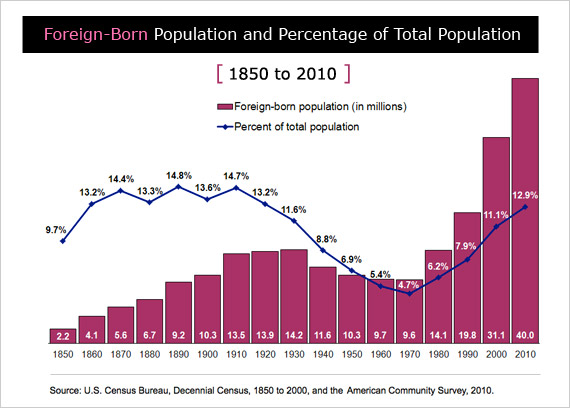The Census Bureau last week provided a statistical glimpse into the lives of immigrants in the U.S. In a report based on data from the 2010 American Community Survey, the bureau illustrated how the foreign-born population – including naturalized citizens, legal residents, and both documented and undocumented migrants – has climbed over the last four decades and now totals the highest portion of the population since the 1920s.
Even as an increasing number of immigrants are now choosing to return home, the U.S in 2010 was home to 40 million foreign-born residents – the most ever. That includes 17.5 million naturalized citizens and 22.5 million noncitizens. The 40 million is up from 31.1 million in 2000 and dramatically higher than the 9.6 million foreign-born people living in the country in 1970.
The Census Bureau says that more than half of that immigrant population has come to the U.S. since 1990, with about a third entering the country since 2000. “If you look at the pattern of increase over the decade, most of the increase occurred really between 2000 and 2006, and the growth of the foreign-born population slowed in the latter half of the decade,” Elizabeth Grieco, head of the Census Bureau's Foreign-Born Population Branch, told reporters during a presentation last week.
RELATED: U.S.-Educated Immigrants Return to Their Homelands
The influx has helped push the share of the population that was born outside the U.S. to its highest level since 1920, and close to where it was a century ago, when the great migration wave of the late 1800s and early 1900s made immigrants close to 15 percent of the U.S. population. Immigrants made up almost 13 percent of the total population in 2010, compared with 11.1 percent in 2000 and 4.7 percent in 1970.

More than half (53 percent) of the foreign-born residents of the U.S. come from Latin America and the Caribbean, including 11.7 million people born in Mexico, who account for 29 percent of the total immigrant population. Another 28 percent of immigrants hail from Asia, and 12 percent from Europe.
The immigrant population in the U.S. is also concentrated in a handful of “gateway” states. California, New York, Texas and Florida were home to more than half of the country’s immigrant population in 2010. A quarter all immigrants in the U.S. live in California -- and those immigrants make up 27 percent of the state’s population. About one in nine immigrants in the U.S. live in New York, with another 10 percent in Texas and 9 percent in Florida.

The Census report also breaks down some of the differences between today’s immigrant population and native-born citizens. Foreign-born households, for example, are larger on average than households of native citizens, have more children under the age of 18, and are more likely to have several generations under one roof. Immigrants are more likely to be married (58 percent of those 15 and older vs. 47 percent for born in the U.S.) and have a higher fertility rate (with 70 births per 1,000 women, compared with 52 births per U.S.-born women). And the foreign-born population, on the whole, tends to be less educated, with 68 percent having a high-school degree or higher level of schooling compared to 89 percent of the population born in the U.S.
While immigrants are active in the labor force – 68 percent of those 16 or older were working, compared with 64 percent of those born in the U.S. – they still face an overall financial gap compared with native citizens. Foreign-born households have a lower median income than native-born households: $46,224, compared with $50,541. About 19 percent of the foreign-born residents were living below the poverty line, compared with 15 percent of the native population. And 66 percent of the foreign-born population had health insurance, compared with 87 percent of the native-born population.





